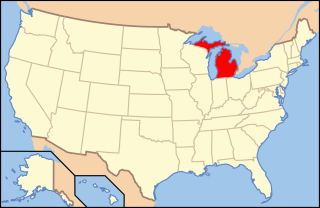
In the United States, the availability of legally-recognized same-sex marriage expanded from one state in 2004 to all fifty states in 2015 through various state and federal court rulings, state legislation, and direct popular votes. The fifty states each have separate marriage laws, which must adhere to rulings by the Supreme Court of the United States that recognize marriage as a fundamental right that is guaranteed by both the Due Process Clause and the Equal Protection Clause of the Fourteenth Amendment to the United States Constitution, as first established in the 1967 landmark civil rights case of Loving v. Virginia.

Utah Constitutional Amendment 3 was an amendment to the Utah state constitution that sought to define marriage as a union exclusively between a man and woman. It passed in the November 2, 2004, election, as did similar amendments in ten other states.
In response to court action in a number of states, the United States federal government and a number of state legislatures passed or attempted to pass legislation either prohibiting or allowing same-sex marriage or other types of same-sex unions.
Same-sex marriage has been legally recognized in the U.S. state of Florida since January 6, 2015, as a result of Brenner v. Scott, the lead case on the issue. In this case, a U.S. district court ruled the state's same-sex marriage ban unconstitutional on August 21, 2014. The order was stayed temporarily; state attempts at extending the stay failed, with the U.S. Supreme Court denying further extension on December 19, 2014.
Same-sex marriage has been legally recognized in Utah since December 20, 2013, when the state began issuing marriage licenses to same-sex couples as the result of Judge Robert J. Shelby of the U.S. District Court for Utah ruling in the case of Kitchen v. Herbert, which found that barring same-sex couples from marriage violated the U.S. Constitution. The issuance of those licenses was halted during the period of January 6, 2014 until October 6, 2014, following the resolution of a lawsuit challenging the state's ban on same-sex marriage. On that day, following the U.S. Supreme Court's refusal to hear an appeal in a case that found Utah's ban on same-sex marriage unconstitutional, the Tenth Circuit Court of Appeals ordered the state to recognize same-sex marriage.
Same-sex marriage has been legally recognized in the U.S. state of Nevada since October 9, 2014, when a federal district court judge issued an injunction against Nevada's enforcement of its ban on same-sex marriage, acting on order from the Ninth Circuit Court of Appeals. A unanimous three-judge panel of the Ninth Circuit had ruled two days earlier that the state's ban on same-sex marriage was unconstitutional. Same-sex marriage was previously banned by an amendment to the Constitution of Nevada adopted in 2002.

Lesbian, gay, bisexual, and transgender (LGBT) persons in the U.S. state of Michigan may face legal challenges not faced by non-LGBT residents. Same-sex sexual activity is legal in Michigan, as is same-sex marriage. Discrimination on the basis of sexual orientation and gender identity is not explicitly banned within state law. However, a ruling of the Sixth Circuit Court of Appeals and a decision of the Michigan Civil Rights Commission have ensured that members of the LGBT community are not discriminated against and are protected in the eyes of the law.
Same-sex marriage is legal in the U.S. state of Michigan and all other U.S. states as per the U.S. Supreme Court ruling of Obergefell v. Hodges on June 26, 2015. The state had banned recognition of same-sex unions in any form since a 2004 popular vote added an amendment to the State Constitution. Previously, a statute enacted in 1996 banned both the licensing of same-sex marriages and the recognition of same-sex marriages from other jurisdictions.
Same-sex marriage has been legally recognized in the U.S. state of Arizona since October 17, 2014. The state had denied marriage rights to same-sex couples by statute since 1996 and by an amendment to its State Constitution approved by voters in 2008. Two lawsuits in federal court that challenged the state's policies ended with a decision that the ban was unconstitutional and the state did not appeal that ruling.
The U.S. state of Montana has recognized same-sex marriage since a federal court ruled the state's ban on same-sex marriage unconstitutional on November 19, 2014. It had previously denied marriage rights to same-sex couples by statute since 1997 and in its State Constitution since 2004. The state appealed the ruling to the Ninth Circuit Court of Appeals, but before that court could hear the case, the U.S. Supreme Court struck down all same-sex marriage bans in the country, mooting any remaining appeals.
Same-sex marriage has been legally recognized in the U.S. state of North Carolina since October 10, 2014, when a U.S. District Court judge ruled in General Synod of the United Church of Christ v. Cooper that the state's denial of marriage rights to same-sex couples was unconstitutional. The state's Governor and Attorney General had acknowledged that a recent ruling in the Fourth Circuit Court of Appeals and the U.S. Supreme Court's decision not to hear an appeal in that case established the unconstitutionality of North Carolina's ban on same-sex marriage. State legislators sought without success to intervene in lawsuits to defend the state's ban on same-sex marriage.
Same-sex marriage has been legally recognized in the U.S. state of Indiana since October 6, 2014. The state had previously restricted marriage to male-female couples by statute in 1986. By legislation passed in 1997, it denied recognition to same-sex relationships established in other jurisdictions. A lawsuit challenging the state's refusal to grant marriage licenses to same-sex couples, Baskin v. Bogan, won a favorable ruling from the U.S. District Court for the Southern District of Indiana on June 25, 2014. Until the U.S. Court of Appeals for the Seventh Circuit granted an emergency stay of the district court's ruling on June 27, most Indiana counties issued marriage licenses to same-sex couples. The Court of Appeals affirmed the district court's ruling in Baskin on September 4. A ruling in Bowling v. Pence stated that the state must recognize same-sex marriages performed out-of-state and the decision was stayed until the Circuit ruled on the merits in similar cases. It also stated that the ruling would remain stayed if the circuit court stayed its decision in the related cases.
Same-sex marriage has been legally recognized in the U.S. state of Alaska since October 12, 2014, with an interruption from October 15 to 17 while state officials sought without success to delay the implementation of a federal court ruling. A U.S. District Court held on October 12 in the case Hamby v. Parnell that Alaska's statutory and constitutional bans on same-sex marriage violated the Due Process and Equal Protection clauses of the United States Constitution. On October 15, state officials obtained a two-day stay from the Ninth Circuit Court of Appeals, which the United States Supreme Court refused to extend on October 17.
United States v. Windsor, 570 U.S. 744 (2013), is a landmark United States Supreme Court civil rights case concerning same-sex marriage. The Court held that Section 3 of the Defense of Marriage Act (DOMA), which denied federal recognition of same-sex marriages, was a violation of the Due Process Clause of the Fifth Amendment.

North Carolina Amendment 1 was a legislatively referred constitutional amendment in North Carolina that amended the Constitution of North Carolina to prohibit the state from recognizing or performing same-sex marriages or civil unions. The amendment did not prohibit domestic partnership agreements, but defined male–female marriage as "the only domestic legal union" considered valid or recognized in the state. On May 8, 2012, North Carolina voters approved the amendment, 61% to 39%, with a voter turnout of 35%.
This page contains a timeline of significant events regarding same-sex marriage in the United States. On June 26, 2015, the landmark US Supreme Court decision in Obergefell v. Hodges effectively ended restrictions on same-sex marriage in the United States.
The U.S. state of Texas issues marriage licenses to same-sex couples and recognizes those marriages when performed out-of-state. Prior to the U.S. Supreme Court's ruling striking down all state bans on same-sex marriage, Article 1, Section 32, of the Texas Constitution provided that "Marriage in this state shall consist only of the union of one man and one woman," and "This state or a political subdivision of this state may not create or recognize any legal status identical or similar to marriage." Prohibition of same-sex marriage and civil unions also exist in Texas statute. This amendment and all related statutes have been ruled unconstitutional. Some cities and counties in the state recognize both same-sex and opposite-sex domestic partnerships.
Same-sex marriage has been legally recognized in the U.S state of Idaho since October 15, 2014.
Same-sex marriage is legal in the U.S. state of Mississippi. On November 25, 2014, U.S. District Court Judge Carlton W. Reeves of the District Court for Southern Mississippi, ruled Mississippi's ban on same-sex marriage unconstitutional. Enforcement of his ruling stayed pending appeal to the Fifth Circuit Court of Appeals. On June 26, 2015, the U.S. Supreme Court ruled in Obergefell v. Hodges that the denial of marriage rights to same-sex couples is unconstitutional. On June 29, the State Attorney General ordered clerks to issue marriage licenses to same-sex couples. On July 1, the Fifth Circuit lifted its stay and Judge Reeves ordered an end to Mississippi's enforcement of its same-sex marriage ban. However, until July 2, 2015, several counties in Mississippi continued to refuse to issue same-sex couple marriage licenses, including DeSoto, Jasper, Jones, Newton, Pontotoc, Simpson and Yalobusha.
The history of same-sex marriage in the United States dates from the early 1970s, when the first lawsuits seeking legal recognition of same-sex relationships brought the question of civil marriage rights and benefits for same-sex couples to public attention though they proved unsuccessful. The subject became increasingly prominent in U.S. politics following the 1993 Hawaii Supreme Court decision in Baehr v. Miike that suggested the possibility that the state's prohibition might be unconstitutional. That decision was met by actions at both the federal and state level to restrict marriage to male-female couples, notably the enactment at the federal level of the Defense of Marriage Act.




